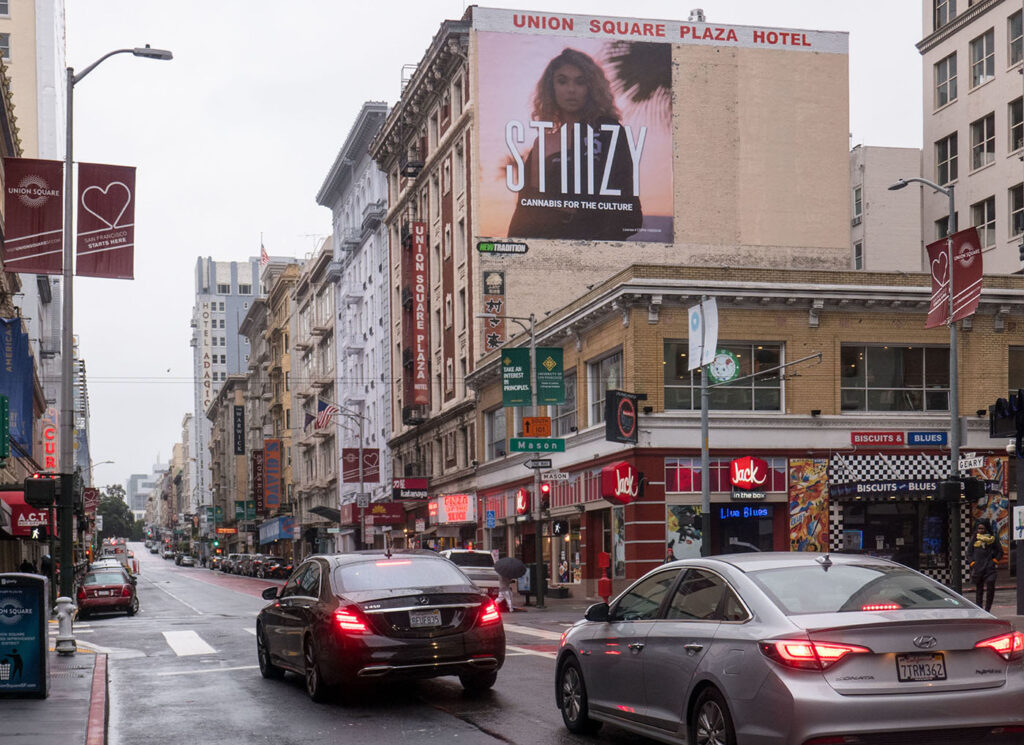Brands’ customers are retailers, and retailers’ customers are consumers. This has created a major advantage for retailers, because it places the most direct relationship with consumers—the ultimate source of all revenue—squarely in retailers’ hands. Stores know their customers’ names, email addresses or phone numbers, product preferences, how much they spend, how frequently they shop, and more. Retailers can incorporate loyalty programs and redeemable coupons, text-message deals, and email marketing to bring in new people and nurture strong lifetime value. Brands don’t have that kind of access to feedback or data.
“Whoever owns the customer relationship owns the leverage,” said Rob Costello, partner and chief growth strategist at 10K Advertising, a marketing firm that helps dispensaries and brands build their audiences. “The biggest advantage of owning the end consumer is getting the opportunity to guide what they buy. This has been the primary reason why brands have had to focus so many resources at the retail level. They essentially are renting their customers.”
At present, brands know very little about the people who buy their products. They lose touch with them as soon as they leave the store locator on the brand’s website. Maybe the lead went to a store and purchased products, but maybe they didn’t. If they did make a purchase, brands have no way to track it or contact the consumer for feedback or to offer promotions. Only the retailer can do that.
Depending on the sophistication of the retailer’s data operation and their categorization of customer preferences, leaving communication in their court could be actively detrimental to a brand.
Let’s outline a nightmare scenario: Assume you’re a flower producer. You direct a customer to a dispensary via your awesome, expensive website, and they buy an eighth. The dispensary registers the transaction in its point-of-sale system and segments the customer as a flower consumer, but not necessarily a consumer of your flower. The following week, that customer receives a text message from the dispensary alerting them to a deal on products produced by your biggest competitor. In a matter of minutes, your customer becomes your competitor’s customer. The retailer doesn’t have an obligation or much incentive to direct that customer back to your product. This is their customer. Their priority is to get confirmed spenders back into the store.
Brand loyalty in cannabis remains largely elusive, and the reasons for this become clearer once you understand how disconnected brands and consumers are. At best, a brand can use QR codes and calls to action on their packaging to drive purchasers into their marketing funnel. But those tactics require customers to take action beyond the purchase, and many don’t.
Direct-to-consumer ecommerce
In response to this problem, major brands have begun experimenting with direct-to-consumer (D2C) ecommerce by partnering with local cannabis delivery services. Customers within a given delivery radius can place an order on a brand’s website via a white-labeled checkout system powered by the delivery platform, which then fulfills the order. In essence, the brand is paying for the cost of customer acquisition, and in exchange the delivery service relinquishes control of the data, allowing the brand to start its own conversation with customers.
“The two main benefits of a successful D2C program are more favorable margins [compared to wholesale] and access to detailed customer data,” said Costello, whose company brokers D2C relationships between brands and delivery platforms. “Delivery services like Grassdoor and Budee do a phenomenal job making a brand’s direct customer data accessible and easy to read.”
Infused beverage sensation Cann partnered with Grassdoor to fulfill Los Angeles area orders processed through Cann’s website. So far, the collaboration has been an overwhelming success. “D2C went from zero to being our biggest account in six months,” said Cann co-founder Luke Anderson. “We are now doing 15 percent to 20 percent of overall sales from D2C, and the traffic is largely organic from Instagram and email sign ups.”

Cann’s profile rose considerably during the pandemic, coinciding with the public’s major shift to online retail. “Everyone was sitting at home and it was just as easy to buy alcohol and get it delivered to their house as it was to get Cann delivered on Eaze or D2C,” said Anderson.
Cann also is working to capture customers who purchase in brick-and-mortar stores through prompts on packaging that encourage them to enter Cann’s digital funnel. “We’ve got a lot of details on the packaging that invite people to be a part of our ecosystem on Instagram,” said Anderson. “Eventually you’ll sign up for email marketing or you’ll go to the website, and then you’ll get stuck in our D2C repurchasing experience.”
Brands like Cann have spent a tremendous amount of time, money, and effort developing a unique voice that resonates with thousands of people. Owning a direct communication channel with those consumers, enabling purchases to be fulfilled and measured, is the next logical step, and its impact reaches farther than just D2C sales.
“Brands are starting to see the tremendous value in owning the customer,” said Costello. “As they invest more dollars in their own customer acquisition, they are learning a lot more about their true target customer, generating valuable data to make their sales team’s efforts more efficient, and gaining leverage when opening new retail accounts.”
When the price is right
When it comes to opening more retail accounts, pricing is the most important single detail for retailers. Set the wholesale price too high, and the chances a buyer will take a risk on your brand decrease. Set the price too low and you risk putting too much downward pressure on margins, leaving yourself unable to offer deals, which are essential for a successful to-market strategy.
“What we’ve seen is when you have the right price-to-quality ratio, there’s a connection made between the brand and the buyer,” said Mike Beaudry, founder and chief executive officer at distributor HERBL.
Beaudry’s team has an extensive alignment checklist they use to determine whether a brand can be a successful presence in its category, and correct pricing is at the top of the list. “Get it right and there seems to be a willingness at the buyer level to stock the product, and often all the SKUs from that product line,” he said. “But get it wrong and we’ll never know how consumers respond, because the products won’t make it onto the shelves.”
A fateful pricing adjustment was a catalyst in Cann’s rise in 2020. After some digging into the product’s sluggish sales velocity, Anderson observed that unlike the beer and wine Cann pitts itself against, the brand’s little 2mg cans were savored, not enjoyed as a routine social libation. “We want Cann to be an alcohol substitute,” said Anderson, who spent six years as a consumer packaged goods (CPG) consultant at Bain & Company prior to launching Cann. “Nobody is treasuring their White Claws and saving them for special occasions.”

The problem was the price. “It was just too expensive,” he said. “Taxes brought the price to $38 out the door for a six pack, and that meant people were keeping them as a special treat. We dropped [the price] to $24 at some retailers, and we saw the velocity triple.”
Once Cann had a price point that resonated relative to alcohol alternatives and not dollars-per-milligram cannabis products, the company’s sales increased dramatically and its products cracked the cannabis-infused-beverage category wide open.
But pricing is just the first step in what Beaudry describes as an “obstacle course” to opening new accounts and creating success. “You first have to get in the door, then get past the buyer or the owner, then get the budtenders on board, and finally convince the consumer,” he said. “It’s tough, and a lot of brands don’t fully understand the obstacle course—particularly those coming from traditional CPG.”
Differentiation
Clear differentiation from the competition is of enormous help for brand loyalty. “Say you’re coming in with a vape,” Beaudry said. “Who are the top players and why? What kind of oil are you using? Are you able to demonstrate some level of differentiation? If you just say, ‘I have a vape pen. It has CO2 oil and it’s X dollars per gram,’ that’s not going to win many hearts and minds at this point.”
Ciencia Labs launched its cannabis sleep brand dreamt in December 2019. Entering the market with a comparatively expensive vape, co-founder and Chief Operating Officer Benjamin Mitchell leaned heavily on the science supporting the products to open doors. Science “was the biggest differentiator for us,” he said. “The stores all knew people were coming in and looking for something for sleep, so we explained to them that our products were supported by science and the others weren’t. We showed them the research and taught them how to explain the science to consumers.”
Beyond having the right product for a certain segment of the store, Mitchell quickly learned buyers dictate the terms and new brands should be prepared to “meet the store wherever they are.” The store is “the customer, and you have to give them the things they need in order to buy,” he said. “If that means terms, small orders, or aggressive amounts of sell-through assistance in the form of [patient appreciation days] and promos, then so be it. You need to do those things to open new accounts, especially when you’re a new brand and don’t yet have a reputation or credibility.”
Building credibility is particularly important in a nascent marketplace with a relatively uninformed consumer base. One of the most effective paths toward credibility is winning the support of budtenders. Because of their direct, frequent interaction with customers, budtenders play an enormous role in helping brands develop the kind of traction needed to become successful. They will recommend products in which they see value, but if they think the price-to-quality ratio is off or they simply don’t know anything about the brand because no representatives have visited the store, brands can become invisible.
“Until it’s more like traditional retail where you walk in and pull things off the shelf, I see budtenders continuing to play an important role,” said Beaudry. “If you think about CVS, Walmart, anywhere in retail America, you go in by yourself, make decisions by yourself, and buy by yourself. In a dispensary, customers are assisted through the purchase. If you don’t have the attention of that budtender, your competitors’ products are going to move faster than yours.”
Budtenders rule for brand loyalty
Getting buy-in from budtenders can take a couple of different forms, but ultimately should start with making sure they have actually tried the products. “Every budtender needs a sample,” said Mitchell. “They’re the ones fielding questions and making recommendations. Consumers look to them as trusted experts who know the products. With our dreamt brand, given that it’s effect-based, science-backed, and actually works, we wanted as many budtenders as possible to try it so they could see that and recommend the product.”
Over the past year, budtenders’ influence has waned as buying decisions increasingly moved online with transactions completed in person. Ecommerce platform IHeartJane reported online orders went from 15 percent of total transactions pre-pandemic to more than 50 percent at the pandemic’s height. Since then the number has stabilized at around 40 percent, but that still represents a significant shift in how people find and buy cannabis.
“We went from having no online orders to being in the top five for dispensaries within the area,” said Francesca Dominguez, marketing manager for Atrium in Woodland Hills, California. The shift led the store to invest more heavily in its top-of-funnel digital strategy, zeroing in on search engine optimization (SEO) as a particularly fruitful area for resources investment. “We are seeing a lot more people using Google to find us,” Dominguez said. “We are putting more money in SEO over Weedmaps to improve our [return on investment].”
Marketing strategies
Interestingly, Dominguez isn’t the only expert turning away from Weedmaps. 10K Advertising’s Costello has begun steering clients away from the high-dollar, high-competition playing field in favor of reaching customers through Google. “If you’re going to Weedmaps to buy weed, you’re probably more concerned with deals,” he said. “This makes it a race to the bottom and keeps the customer switching between stores whenever they want to re-up.”
Costello compared the value of customers arriving at Ganjarunner’s website from Weedmaps versus those arriving from Google. He found the lifetime value to be significantly higher when customers arrived via organic search and promptly reoriented their strategy around SEO. “With Weedmaps, you’re putting money in to play the game; you’re not investing in true growth,” he said. “It’s a bloodbath to maintain visibility. Google is a long-term investment.”
Billboards continue to be a reliable way to kickstart local organic searches, yet they are one of the most controversial issues in cannabis marketing. Aside from being visible to anyone regardless of age or moral disposition, ROI for out-of-home (OOH) marketing is notoriously difficult to quantify. The hefty price tag and opaque impact can be a risky investment, particularly for brands. But for retailers, billboards and other OOH channels represent a powerful tool for top-of-funnel awareness.

“Put a billboard up in your neighborhood and you are essentially planting a flag and letting your community know you exist and are open for business,” said Costello. “Much like brands, retailers are fighting for market share constantly. The only way to gain that is to be top of mind. You can’t do that without having a hyper-local offline presence.”
Dispensaries are well placed to advertise on billboards. With a tight radius and a simple call to action (“buy weed at this address”), they can increase foot traffic considerably. “Billboards have been one of our most successful [investments],” said Dominguez. “We currently have seven of them, and new guests often mention how they have seen them around before coming in.”
Customer retention
Lisa Gee, vice president of marketing and corporate social responsibility (CSR) at Colorado dispensary chain Lightshade, has advice for stores worried about losing customer share to brands. Customer retention is a multi-pronged effort, she said, starting with providing a high level of care to each customer. “We know the most important aspect of customer loyalty is the level of service a person receives when visiting a store,” Gee said. “From the initial contact at the front desk throughout the customer relationship, we focus on providing a personal touch.”
Lightshade maintains regular contact with its customer base via email and text messages, offering week-long buy-one-get-one promotions, updates about brands, and local CSR initiatives—an area of particular interest to the chain’s consumers. “Providing our customers insight into the chain’s activism around supporting expungement and diversity and equity has been significant [for retention],” Gee said.
Moving forward
Techniques for retaining and engaging customers at the retail and brand levels haven’t changed significantly in recent years, but the battle to acquire new customers has, particularly when it comes to access and ownership of the customer relationship. At the moment, D2C is in its earliest iteration and largely limited to California, where heated competition between tech-forward delivery services has made the leap possible. But California always has been a bellwether. Recent job postings from Cookies and Seth Rogan’s Houseplant suggest the companies are building major D2C operations. Given D2C solves one of the biggest pain points for brands, expect to see it replicated in other markets.
“I see brands having a lot of control,” said Costello, who added his company is seeing an increasing number of brands seeking D2C integration. “I think those that catch on late are going to be wiped out, because this game has already started and it’s not just big players that are getting in on the action.”
Brick-and-mortar stores should consider pandemic-initiated shifts a wake-up call. In mature markets, stores have enjoyed a long run of total ownership of the customer relationship. Some have used the advantage to great effect; others have been complacent. Brands now demand access to customers in order to build brand loyalty, and they’re becoming more capable of cutting stores out of the middle. If retailers don’t find ways to offer access, they risk becoming obsolete.
On the other hand, if stores work with brands to create complementary customer acquisition and retention strategies, both will benefit as society settles into “new normal” commerce.














[…] With the United States ready to reclassify marijuana from Schedule I to Schedule III, experts speculate more states will embrace legalization—a budding potential for new markets. As the industry grows, retail establishments’ success hinges significantly on the caliber of talent employed, and the demand is rising for knowledgeable, dedicated staff. Whether assisting customers in selecting the right strain, ensuring compliance with regulations, or cultivating a welcoming atmosphere, the people behind the counter play a pivotal role in shaping the customer experience, driving business growth, and cultivating brand loyalty. […]
[…] purchase, and enjoy products while simultaneously empowering retailers to optimize operations and foster customer loyalty. From improving store efficiency to encouraging deeper connections between consumers and brands, […]
[…] When one platform easily integrates with other tools in a business’s tech stack, it fosters brand loyalty by creating connected experiences that follow a consumer across multiple touchpoints with a given […]
[…] tiniest museums, these shops used their surroundings to create an experience so unforgettable, customers likely decided to become regulars without fully understanding […]
[…] correctly, the following six margin-friendly strategies can keep inventory turning while working to establish brand loyalty without sacrificing […]
[…] insight the Flowhub ecosystem provides Sherman and his team about consumer behavior and retailer and brand loyalty — and, consequently, customer acquisition and retention strategies that […]
[…] Dispensaries are most successful when the design is infused into the brand identity and narrative. Hospitality has done this for quite a while with themed hotels featuring highly conceptual storytelling designs that appeal to travelers worldwide. Basing the dispensary design on the brand identity also allows retailers to adapt to changing market conditions. Dispensary design that is interwoven with the brand’s story and identity is not only timeless but also more likely to attract a loyal customer base. […]